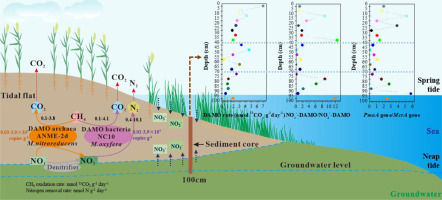Our official English website, www.x-mol.net, welcomes your
feedback! (Note: you will need to create a separate account there.)
Denitrifying anaerobic methane oxidation in intertidal marsh soils: Occurrence and environmental significance
Geoderma ( IF 5.6 ) Pub Date : 2020-01-01 , DOI: 10.1016/j.geoderma.2019.113943 Yanling Zheng , Lijun Hou , Feiyang Chen , Jie Zhou , Min Liu , Guoyu Yin , Juan Gao , Ping Han
Geoderma ( IF 5.6 ) Pub Date : 2020-01-01 , DOI: 10.1016/j.geoderma.2019.113943 Yanling Zheng , Lijun Hou , Feiyang Chen , Jie Zhou , Min Liu , Guoyu Yin , Juan Gao , Ping Han

|
Abstract Denitrifying anaerobic methane oxidation (DAMO), consisting of nitrite-dependent DAMO (nitrite-DAMO) and nitrate-dependent DAMO (nitrate-DAMO), has recently been discovered and considered an important link between carbon and nitrogen cycles. In this work, we investigated biodiversity, abundance, and potential methane (CH4) oxidation activity of nitrite-DAMO bacteria and nitrate-DAMO archaea in intertidal marsh soil cores, based on molecular and stable isotope tracing methods. Results evidenced the co-occurrence and vertical stratification of DAMO bacteria and archaea in intertidal marsh soils, with higher biodiversity of DAMO archaea compared with DAMO bacteria. The abundance of DAMO bacterial pmoA gene (8.2 × 105–3.0 × 107 copies g−1 dry soil) was approximate to that of DAMO archaeal mcrA gene (3.0 × 105–3.9 × 107 copies g−1 dry soil) in the intertidal marsh soil cores. Stable isotope experiments showed that DAMO bacteria and archaea were both active in the intertidal marshes, with CH4 oxidation potential of 0.1–3.8 nmol 13CO2 g−1 dry soil day−1 and 0.1–4.1 nmol 13CO2 g−1 dry soil day−1, respectively. The relative importance (including the abundance and CH4 oxidation activity) of DAMO bacteria and archaea showed significant vertical variations, with more contribution by DAMO bacteria at the soil-tidal water interface and soil-groundwater interface layers of the soil cores, which are largely due to the influence of tidal dynamics. In addition to playing an important role as CH4 sink, DAMO process was also a non-negligible pathway of nitrogen removal in intertidal marsh soils, with an estimated nitrogen removal rate of 0.4–10.1 nmol N g−1 dry soil day−1. Overall, these results illustrated the occurrence and environmental significance of DAMO bioprocess in intertidal marshes.
中文翻译:

潮间带沼泽土壤中反硝化厌氧甲烷氧化:发生和环境意义
摘要 反硝化厌氧甲烷氧化 (DAMO) 由亚硝酸盐依赖性 DAMO (亚硝酸盐-DAMO) 和硝酸盐依赖性 DAMO (硝酸盐-DAMO) 组成,最近被发现并被认为是碳和氮循环之间的重要联系。在这项工作中,我们基于分子和稳定同位素示踪方法研究了潮间带沼泽土壤核心中亚硝酸盐-DAMO 细菌和硝酸盐-DAMO 古细菌的生物多样性、丰度和潜在的甲烷 (CH4) 氧化活性。结果表明,在潮间带沼泽土壤中,DAMO 细菌和古细菌共生和垂直分层,与 DAMO 细菌相比,DAMO 古细菌具有更高的生物多样性。DAMO 细菌 pmoA 基因的丰度(8.2 × 105–3.0 × 107 拷贝 g-1 干燥土壤)与 DAMO 古菌 mcrA 基因的丰度(3.0 × 105–3. 9 × 107 份 g−1 干燥土壤)在潮间带沼泽土壤核心中。稳定同位素实验表明,DAMO 细菌和古细菌在潮间带沼泽中均活跃,CH4 氧化电位为 0.1–3.8 nmol 13CO2 g−1 干土 day−1 和 0.1–4.1 nmol 13CO2 g−1 干土天−1,分别。DAMO 细菌和古细菌的相对重要性(包括丰度和 CH4 氧化活性)显示出显着的垂直变化,其中 DAMO 细菌在土壤核心的土壤 - 潮汐水界面和土壤 - 地下水界面层的贡献更大,这主要是由于潮汐动力学的影响。除了作为 CH4 汇发挥重要作用外,DAMO 过程也是潮间带沼泽土壤中不可忽视的脱氮途径,估计脱氮率为 0.4-10。1 nmol N g−1 干燥土壤 day−1。总体而言,这些结果说明了 DAMO 生物过程在潮间带沼泽中的发生和环境意义。
更新日期:2020-01-01
中文翻译:

潮间带沼泽土壤中反硝化厌氧甲烷氧化:发生和环境意义
摘要 反硝化厌氧甲烷氧化 (DAMO) 由亚硝酸盐依赖性 DAMO (亚硝酸盐-DAMO) 和硝酸盐依赖性 DAMO (硝酸盐-DAMO) 组成,最近被发现并被认为是碳和氮循环之间的重要联系。在这项工作中,我们基于分子和稳定同位素示踪方法研究了潮间带沼泽土壤核心中亚硝酸盐-DAMO 细菌和硝酸盐-DAMO 古细菌的生物多样性、丰度和潜在的甲烷 (CH4) 氧化活性。结果表明,在潮间带沼泽土壤中,DAMO 细菌和古细菌共生和垂直分层,与 DAMO 细菌相比,DAMO 古细菌具有更高的生物多样性。DAMO 细菌 pmoA 基因的丰度(8.2 × 105–3.0 × 107 拷贝 g-1 干燥土壤)与 DAMO 古菌 mcrA 基因的丰度(3.0 × 105–3. 9 × 107 份 g−1 干燥土壤)在潮间带沼泽土壤核心中。稳定同位素实验表明,DAMO 细菌和古细菌在潮间带沼泽中均活跃,CH4 氧化电位为 0.1–3.8 nmol 13CO2 g−1 干土 day−1 和 0.1–4.1 nmol 13CO2 g−1 干土天−1,分别。DAMO 细菌和古细菌的相对重要性(包括丰度和 CH4 氧化活性)显示出显着的垂直变化,其中 DAMO 细菌在土壤核心的土壤 - 潮汐水界面和土壤 - 地下水界面层的贡献更大,这主要是由于潮汐动力学的影响。除了作为 CH4 汇发挥重要作用外,DAMO 过程也是潮间带沼泽土壤中不可忽视的脱氮途径,估计脱氮率为 0.4-10。1 nmol N g−1 干燥土壤 day−1。总体而言,这些结果说明了 DAMO 生物过程在潮间带沼泽中的发生和环境意义。





















































 京公网安备 11010802027423号
京公网安备 11010802027423号